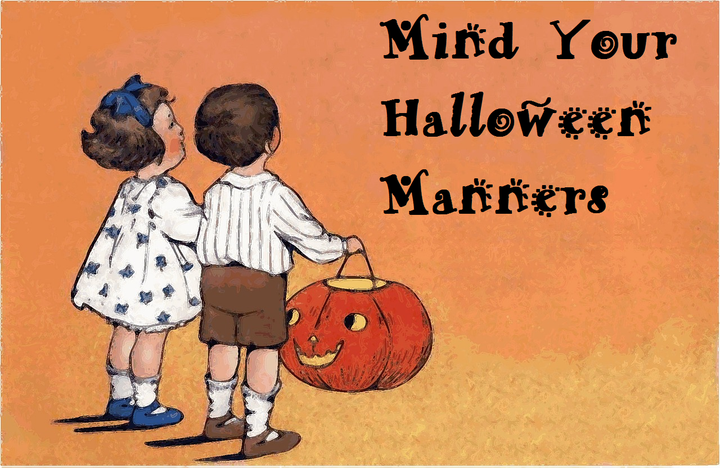
It’s that time of year for carving pumpkins, and for our ghosts and goblins to go trick or treating. As Halloween approaches, consider these modern manners tips:
- Safety: Younger children should wear reflective and light-up glow gear; and be accompanied by parents or a designated chaperone. Older children should trick or treat as part of a group. Be sure vision is not impaired by a mask or make-up. Never enter someone’s home you don’t know no matter how nice they seem. Carry a flashlight and mobile phone. Follow your intuition, if you have a bad feeling about something avoid it. Avoid open flames, use LED instead.
- Avoid homemade treats: While it’s a nice thought to want to bake homemade Halloween treats, don’t do it. Parents have heightened safety concerns for good reason, and will discard any homemade treats including fresh fruits. It is best to buy pre-packaged candy from trusted brands like Hershey, M&M, Skittles, Dove, Reese's.
- Alternatives to Candy: Traditional chocolate or sugar-laced candy are always a hit with trick-or-treaters. With parents being more health conscious, consider sealed mini bottled water, pre-packaged popcorn, coloring books, pre-packaged healthy snacks, small inexpensive toys, or pens/pencils.
- Office and school policies: Some offices encourage employees to dress up while others want nothing to do with it. School policies vary, so don’t assume it’s okay for your children to wear their costumes to school. Many school districts across the nation, dressing up is not allowed for safety reasons. Always double check and never assume.
- Appropriate Costumes: As a role model, guide your children toward costumes that portray a leader. Costumes that represent a culture, race, ethnic or religious group or someone with a serious illness, poverty or other hardship, are inappropriate. Sexually explicit costumes and those mocking LGBT or gender identity encourage negativity. During an election year, our public political figures are certainly on the table. Expect to see versions of Clinton and Trump.
- Age appropriate: While many adults enjoy Halloween dress up, remember this is mostly a children’s holiday. What your teenager might wear, is not a good fit for a first grade Halloween party. Gauge the costume based on your child’s age, and the age of his or her their peers. Even if you think your child might be able to handle dress up as Freddy Krueger, it might be too much for their friends.
- Teach Kids Manners: This is a great opportunity to teach your kids manners, such as greeting and thanking each homeowner who gives them candy. Explain to older kids and teenagers that bullying and pushing smaller kids out of the way won’t be tolerated. When they encounter a bowl of candy at the door, make sure they are considerate to other kids and only take one or two pieces. Make sure stress the importance of respecting their neighbors and the neighborhood. No damaging private property or a homeowner’s decorations, or leaving unwanted candy or wrappers in lawns.
- Knock one time and one time only: If no one answers, move on to the next house. There’s no need to be excessive and knock 10 times. The homeowner might be on an important call or trying to help a baby to sleep. On a related note: know when it’s appropriate to knock. Trick-or-treating generally starts just before sunset and ends by 9 p.m.
- Don’t Arrive Empty handed: If you or your kids are invited to a Halloween party, you must not come empty handed. Always bring something for the host like a food item or bottle of wine, and don’t forget the children. Bring some desserts or games for them to enjoy.
- Lights off? Don’t Ring Doorbell or Knock: By simply turning off the outside lights, you will alert trick-or-treaters to skip your house and go on to the next. Putting the car in the garage removes of question of whether someone is home. As an option, consider leaving a bowl of candy by the front door.
Sharon Schweitzer, J.D., is a cross-cultural consultant, an international protocol expert and the founder of Protocol & Etiquette Worldwide. She is accredited in intercultural management, is the resident etiquette expert for CBS Austin’s We Are Austin, regularly quoted by BBC Capital, Investor’s Business Daily, Fortune, The New York Times, and numerous other media. She is the best-selling, international award-winning author of Access to Asia: Your Multicultural Business Guide, named to Kirkus Review’s Best Books of 2015 and recipient of the British Airways International Trade, Investment & Expansion Award at the 2016 Greater Austin Business Awards.
